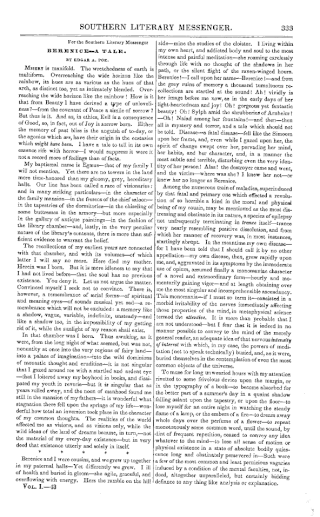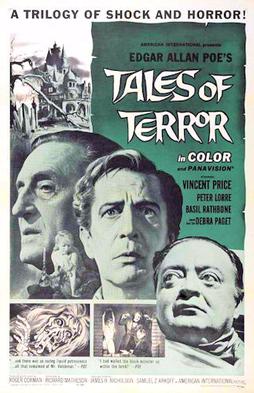Related Research Articles

"The Black Cat" is a short story by the American writer Edgar Allan Poe. It was first published in the August 19, 1843, edition of The Saturday Evening Post. In the story, an unnamed narrator has a strong affection for pets until he perversely turns to abusing them. His favorite, a pet black cat, bites him one night and the narrator punishes it by cutting its eye out and then hanging it from a tree. The home burns down but one remaining wall shows a burned outline of a cat hanging from a noose. He soon finds another black cat, similar to the first except for a white mark on its chest, but he develops a hatred for it as well. He attempts to kill the cat with an axe but his wife stops him; instead, the narrator murders his wife. He conceals the body behind a brick wall in his basement. The police soon come and, after the narrator's tapping on the wall is met with a shrieking sound, they find not only the wife's corpse but also the black cat that had been accidentally walled in with the body and alerted them with its cry.

The Story of Louis Pasteur is a 1936 American black-and-white biographical film from Warner Bros., produced by Henry Blanke, directed by William Dieterle, that stars Paul Muni as the renowned scientist who developed major advances in microbiology, which revolutionized agriculture and medicine. The film's screenplay—which tells a highly fictionalized version of Pasteur’s life—was written by Pierre Collings and Sheridan Gibney, and Edward Chodorov (uncredited).

Henry Graham Greene was an English writer and journalist regarded by many as one of the leading novelists of the 20th century.

"The Masque of the Red Death" is a short story by American writer Edgar Allan Poe, first published in 1842. The story follows Prince Prospero's attempts to avoid a dangerous plague, known as the Red Death, by hiding in his abbey. He, along with many other wealthy nobles, hosts a masquerade ball in seven rooms of the abbey, each decorated with a different color. In the midst of their revelry, a mysterious figure disguised as a Red Death victim enters and makes his way through each of the rooms. Prospero dies after confronting this stranger, whose "costume" proves to contain nothing tangible inside it. The guests also die in turn.
John Dickson Carr was an American author of detective stories, who also published using the pseudonyms Carter Dickson, Carr Dickson, and Roger Fairbairn.

"The Gold-Bug" is a short story by American writer Edgar Allan Poe published in 1843. The plot follows William Legrand, who becomes fixated on an unusual gold-colored bug he has discovered. His servant Jupiter fears that Legrand is going insane and goes to Legrand's friend, an unnamed narrator, who agrees to visit his old friend. Legrand pulls the other two into an adventure after deciphering a secret message that will lead to a buried treasure.

Sir Hugh Carleton Greene was a British television executive and journalist. He was director-general of the BBC from 1960 to 1969.

The Black Mass was a horror-fantasy radio drama produced by Erik Bauersfeld, a leading American radio dramatist of the post-television era. The series aired on KPFA (Berkeley) and KPFK from 1963 to 1967, on an irregular schedule. Bauersfeld was the Director of Drama and Literature at KPFA from 1966 to 1991.

"The Minister's Black Veil" is a short story written by Nathaniel Hawthorne. It was first published in the 1836 edition of The Token and Atlantic Souvenir, edited by Samuel Goodrich. It later appeared in Twice-Told Tales, a collection of short stories by Hawthorne published in 1837.

"The Facts in the Case of M. Valdemar" is a short story by the American author Edgar Allan Poe about a mesmerist who puts a man in a suspended hypnotic state at the moment of death. An example of a tale of suspense and horror, it is also to a certain degree a hoax, as it was published without claiming to be fictional, and many at the time of publication (1845) took it to be a factual account. Poe admitted it to be a work of pure fiction in letters to his correspondents.

Dr Terror's House of Horrors is a 1965 British anthology horror film from Amicus Productions, directed by veteran horror director Freddie Francis, written by Milton Subotsky, and starring Peter Cushing and Christopher Lee.

"Berenice" is a short horror story by American writer Edgar Allan Poe, first published in the Southern Literary Messenger in 1835. The story is narrated by Egaeus, who is preparing to marry his cousin Berenice. He tends to fall into periods of intense focus, during which he seems to separate himself from the outside world. Berenice begins to deteriorate from an unnamed disease until only her teeth remain healthy. Egaeus obsesses over them. When Berenice is buried, he continues to contemplate her teeth. One day, he awakens with an uneasy feeling from a trance-like state and hears screams. A servant reports that Berenice's grave has been disturbed, and she is still alive. Beside Egaeus is a shovel, a poem about "visiting the grave of my beloved", and a box containing 32 teeth.

Tales of Terror is a 1962 American International Pictures Gothic horror anthology film in colour and Panavision, produced by Samuel Z. Arkoff, James H. Nicholson, and Roger Corman, who also directed. The screenplay was written by Richard Matheson, and the film stars Vincent Price, Peter Lorre, and Basil Rathbone. It is the fourth in the so-called Corman-Poe cycle of eight films, largely featuring adaptations of Edgar Allan Poe stories and directed by Corman for AIP. The film was released in 1962 as a double feature with Panic in Year Zero!.

Two Evil Eyes is a 1990 anthology horror film written and directed by George A. Romero and Dario Argento. An international co-production of Italy and the United States, Two Evil Eyes is split into two separate tales, both based largely on the works of Edgar Allan Poe: "The Facts in the Case of M. Valdemar", directed by Romero and starring Adrienne Barbeau; and "The Black Cat", directed by Argento and starring Harvey Keitel, which blends a number of Poe references into a new narrative. Both of the tales were filmed and take place in contemporary Pittsburgh.

Murders in the Rue Morgue is a 1932 American horror film directed by Robert Florey, based on Edgar Allan Poe's 1841 short story "The Murders in the Rue Morgue". The plot is about Doctor Mirakle, a carnival sideshow entertainer and scientist who kidnaps Parisian women to mix their blood with that of his gorilla, Erik. As his experiments fail because of the quality of his victims' blood, Mirakle meets with Camille L'Espanye, and has her kidnapped and her mother murdered, leading to suspicion falling on Camille's fiance, Pierre Dupin, a medical student who has already become interested in the earlier murders.

"Cool Air" is a short story by the American horror fiction writer H. P. Lovecraft, written in March 1926 and published in the March 1928 issue of Tales of Magic and Mystery.
Graham Greene (1904–1991) was an English novelist regarded by many as one of the greatest writers of the 20th century. Combining literary acclaim with widespread popularity, Greene acquired a reputation early in his lifetime as a major writer, both of serious Catholic novels, and of thrillers. He was shortlisted, in 1966 and 1967, for the Nobel Prize for Literature. He produced 26 novels, as well as several plays, autobiographies, and short stories.

Graham's Magazine was a nineteenth-century periodical based in Philadelphia established by George Rex Graham and published from 1840 to 1858. It was alternatively referred to as Graham's Lady's and Gentleman's Magazine, Graham's Magazine of Literature and Art, Graham's American Monthly Magazine of Literature and Art, and Graham's Illustrated Magazine of Literature, Romance, Art, and Fashion.

American poet and short story writer Edgar Allan Poe has had significant influence in television and film. Many are adaptations of Poe's work, others merely reference it.
"Morella" is a short story in the Gothic horror genre by 19th-century American author and critic Edgar Allan Poe.
References
- ↑ Manchester Guardian, 31 December 1931
- ↑ Diemert, Brian (1993). "Recomposing 'Valdemar': Graham Greene reweaves a tale by Poe"
- ↑ Black Mass, My KPFA — A Historical Footnote